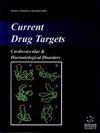BODIPY-TKI偶联物的合成及其靶向表皮生长因子受体能力的研究
IF 3
4区 医学
Q2 PHARMACOLOGY & PHARMACY
引用次数: 0
摘要
一个近红外BODIPY通过其异硫氰酸基团与已知的酪氨酸激酶抑制剂(TKI)厄洛替尼分子通过三甘醇间隔物共价偶联,得到两个新的BODIPY- monotki和BODIPY- ditki偶联物。利用分子模型、表面等离子体共振(SPR)、EGFR激酶结合试验、时间依赖性细胞摄取和荧光显微镜研究了这些偶联物靶向表皮生长因子受体(EGFR)细胞内结构域的能力。虽然BODIPY- monotki和BODIPY- ditki缀合物都被证明通过SPR与EGFR激酶结合,并且在过度表达EGFR的人HEp2细胞中比单独表达BODIPY更有效地积累,但只有BODIPY- monotki表现出激酶抑制活性。这是由于BODIPY-diTKI在水溶液中的高疏水性和聚集行为,如荧光猝灭所示。此外,计算模型表明,在diTKI偶联物中,两个厄洛替尼对激酶活性位点的竞争可能导致相对于monoTKI偶联物的结合减少。然而,两种缀合物的有效细胞摄取和细胞内定位没有观察到细胞毒性,这表明两者都可以用作过表达EGFR的细胞的近红外荧光标记物。本文章由计算机程序翻译,如有差异,请以英文原文为准。
The Synthesis of BODIPY-TKI Conjugates and Investigation of Their Ability to Target the Epidermal Growth Factor Receptor
A near-IR BODIPY was covalently conjugated via its isothiocyanate groups to one or two Erlotinib molecules, a known tyrosine kinase inhibitor (TKI), via triethylene glycol spacers, to produce two novel BODIPY-monoTKI and BODIPY-diTKI conjugates. The ability of these conjugates to target the intracellular domain of the epidermal growth factor receptor (EGFR) was investigated using molecular modeling, surface plasma resonance (SPR), EGFR kinase binding assay, time-dependent cellular uptake, and fluorescence microscopy. While both the BODIPY-monoTKI and the BODIPY-diTKI conjugates were shown to bind to the EGFR kinase by SPR and accumulated more efficiently within human HEp2 cells that over-express EGFR than BODIPY alone, only the BODIPY-monoTKI exhibited kinase inhibition activity. This is due to the high hydrophobic character and aggregation behavior of the BODIPY-diTKI in aqueous solutions, as shown by fluorescence quenching. Furthermore, the competition of the two Erlotinibs in the diTKI conjugate for the active site of the kinase, as suggested by computational modeling, might lead to a decrease in binding relative to the monoTKI conjugate. Nevertheless, the efficient cellular uptake and intracellular localization of both conjugates with no observed cytotoxicity suggest that both could be used as near-IR fluorescent markers for cells that over-express EGFR.
求助全文
通过发布文献求助,成功后即可免费获取论文全文。
去求助
来源期刊

Current drug targets
医学-药学
CiteScore
6.20
自引率
0.00%
发文量
127
审稿时长
3-8 weeks
期刊介绍:
Current Drug Targets aims to cover the latest and most outstanding developments on the medicinal chemistry and pharmacology of molecular drug targets e.g. disease specific proteins, receptors, enzymes, genes.
Current Drug Targets publishes guest edited thematic issues written by leaders in the field covering a range of current topics of drug targets. The journal also accepts for publication mini- & full-length review articles and drug clinical trial studies.
As the discovery, identification, characterization and validation of novel human drug targets for drug discovery continues to grow; this journal is essential reading for all pharmaceutical scientists involved in drug discovery and development.
 求助内容:
求助内容: 应助结果提醒方式:
应助结果提醒方式:


